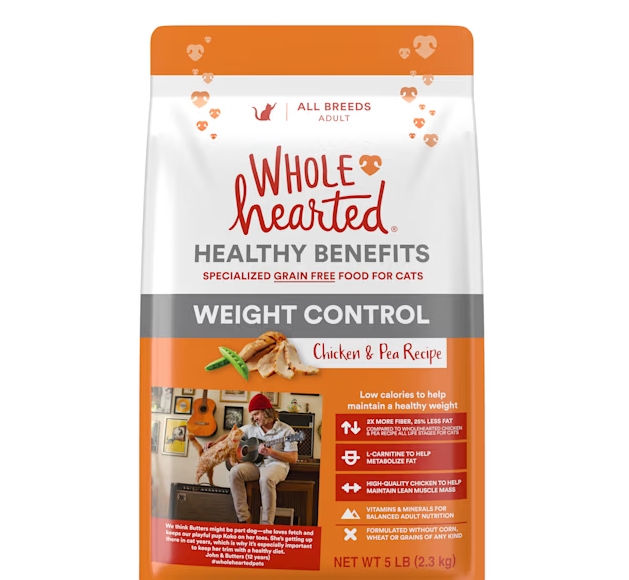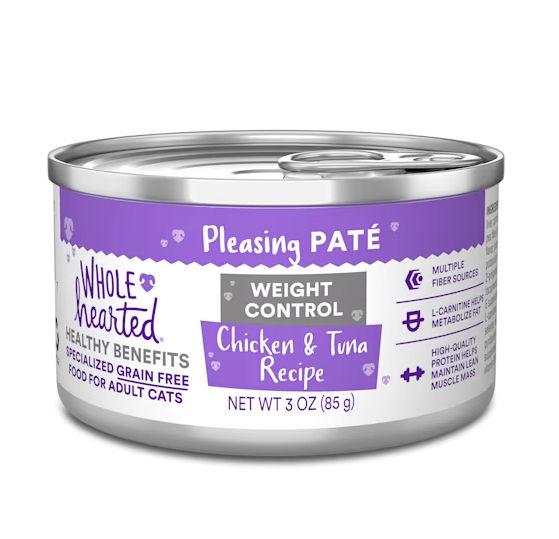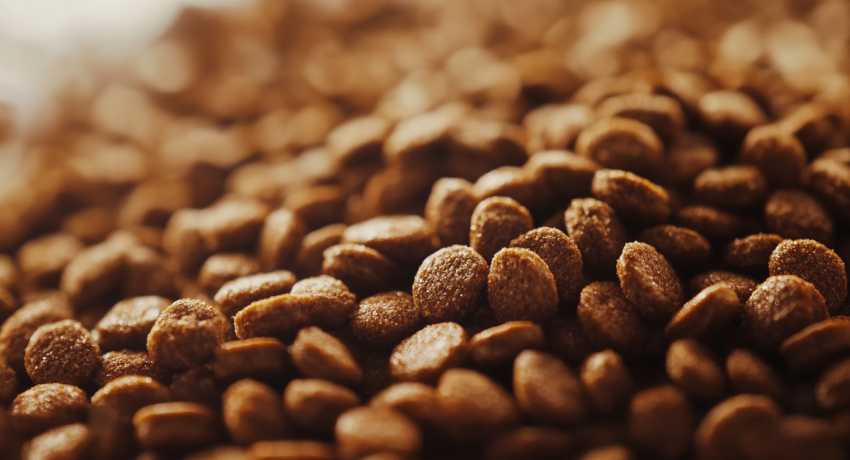
WholeHearted Grain-Free Weight Control Chicken and Pea Recipe Dry Cat Food, 5 lbs.
- The WholeHearted Grain-Free Weight Control Chicken and Pea Recipe Dry Cat Food uses L-Carnitine to help metabolize fat into energy. It also partners with high-quality chicken protein to help maintain and support strong and lean muscle mass.
- – Grain-Free Weight Control Chicken and Pea Recipe Dry Cat Food from WholeHearted
- – Two times more fiber and 50% less fat than whole hearted chicken recipe for cats
- – L-carnitine to help metabolize fat
- – High-quality chicken protein to help maintain lean muscle mass
- – Vitamins and minerals for balanced adult nutrition
- – No corn, wheat, or grains of any kind
$19.99

WholeHearted Weight Control Chicken & Tuna Recipe Adult Wet Cat Food, 5.5 oz. Case of 24
- The WholeHearted Weight Control Chicken & Tuna Recipe Adult Cat Food provides the nutrition to help your pet feel full and maintain a healthy feline figure. This reduced-calorie recipe doesn’t sacrifice on taste, featuring real chicken as the first ingredient, plus antioxidants to bring out the best in your cat.
- – Weight Control Chicken & Tuna Recipe Adult Wet Cat Food from WholeHearted
- – Contains multiple fiber sources to help aid the digestive process
- – Reduced-calorie recipe doesn’t sacrifice on taste
- – Featuring real chicken as the first ingredient
- – Contains antioxidants to help support a healthy immune system
- – No corn, wheat, or grains of any kind
- – No artificial flavors or colors
$37.20
How I Transformed My Chubby Tabby’s Life (And What I Learned Along the Way)
As I sit here with Milo purring contentedly in my lap, it’s hard to believe he’s the same rotund tabby who used to wheeze after just a few minutes of playtime. Six months ago, my veterinarian delivered the news no pet parent wants to hear: “Your cat is clinically obese, and it’s affecting his health.” That moment changed everything for us, sending me on a journey through the world of feline nutrition that eventually led me to Wholehearted Weight Control Cat Food – a discovery that transformed not just Milo’s waistline, but his entire quality of life.
Weight management for cats isn’t just about aesthetics; it’s about longevity, mobility, and happiness. Trust me, I’ve been there – trying to decipher cryptic ingredient lists, comparing countless brands, and wondering if I was making the right choice for my beloved companion. That’s why I’m sharing my comprehensive experience with Wholehearted Weight Control Cat Food – everything I wish I had known from the beginning.
My Personal Journey into Feline Weight Management
Before diving into the specifics of Wholehearted, I want to share a bit about our story. Milo came into my life as a rescue four years ago. Already an adult cat with a healthy appetite, he gradually gained weight under my care. I didn’t notice at first – the change was so gradual, and who doesn’t love a plump, cuddly cat?
But when Milo started having trouble grooming himself and seemed less interested in play, I knew something was wrong. The vet visit confirmed my fears: at 18 pounds, my medium-framed cat was carrying nearly 40% more weight than he should be. The risks were serious: diabetes, joint problems, heart disease, and a shortened lifespan.
I felt terrible. How had I let this happen? My vet assured me this was fixable with the right diet and exercise plan, suggesting a specialized weight management food. That’s when my research began, leading me eventually to Wholehearted’s weight control formula.
What Exactly Is Wholehearted Weight Control Cat Food?
Wholehearted is a pet food brand that’s gained popularity in recent years, particularly among pet parents seeking quality nutrition at a reasonable price point. Their weight control formulation specifically targets cats that need to lose weight or maintain a healthy weight after losing excess pounds.
When I first picked up a bag at my local pet store, I was impressed by their transparency about ingredients and nutritional information. Unlike some other brands that hide behind vague marketing terms, Wholehearted seemed to prioritize clarity.
Breaking Down the Ingredients: What’s Really in the Bag?
The foundation of any good cat food is high-quality protein, and this is where Wholehearted Weight Control really shines. The primary ingredient is real deboned chicken, which provides the essential amino acids cats need without excessive calories.
What impressed me most about the ingredient list was what I didn’t see: no artificial preservatives, no mysterious “by-product meals,” and no low-quality fillers that add calories without nutrition. Instead, I found:
- Chicken as the primary ingredient
- Chicken meal (concentrated protein source)
- Peas and sweet potatoes instead of grains
- Natural fiber sources like dried chicory root
- Added taurine for heart and eye health
- Omega fatty acids for skin and coat health
- Probiotics to support digestive health
The formula includes L-carnitine, which helps convert fat to energy – particularly important for overweight cats. There’s also a thoughtful balance of vitamins and minerals, including antioxidants that support immune function.
What really caught my attention was the fiber content. At approximately 8% crude fiber, it’s significantly higher than standard cat foods (which typically contain 2-4% fiber). This higher fiber content helps cats feel full while consuming fewer calories – essential for weight loss without constant hunger.
Grain-Free: Benefit or Marketing Hype?
One question I had early in my research was whether grain-free formulations like Wholehearted’s were genuinely better for cats or just a marketing trend. After consulting with my veterinarian and doing extensive reading, I learned that while cats don’t necessarily need to avoid all grains, many overweight cats benefit from the lower carbohydrate content that typically comes with grain-free foods.
Wholehearted’s approach uses sweet potatoes and peas as alternative carbohydrate sources. These ingredients provide necessary energy while potentially being easier to digest than some grains. This grain-free formula has worked well for Milo, though I recognize that not all cats have the same dietary needs.
Calorie Control: The Math Behind Weight Loss
For effective weight management, understanding calories is crucial. Wholehearted Weight Control Cat Food contains approximately 325 calories per cup – about 10-15% fewer calories than their regular adult formulas.
When Milo started his weight loss journey, my vet helped me calculate his daily calorie needs. As a rule of thumb, most indoor cats need about 20 calories per pound of ideal body weight for maintenance. For weight loss, we reduced this by about 20%, while ensuring he never went below 200 calories per day (which can be dangerous for cats).
With a target weight of 12 pounds for Milo, his daily calorie goal during weight loss was about 192 calories. This translated to roughly 2/3 cup of Wholehearted Weight Control daily, split between two meals. The measuring cup became my new best friend – no more free-feeding or eyeballing portions!
Flavor Varieties: Keeping Picky Eaters Interested
One challenge with weight management foods is maintaining your cat’s interest over time. Fortunately, Wholehearted offers their weight control formula in multiple flavors, which helped tremendously with Milo’s notorious fickle palate.
The main options include:
- Chicken Recipe
- Salmon Recipe
- Turkey Recipe
- Chicken & Whitefish Recipe
I found rotating between flavors every few weeks helped keep Milo engaged with his food. The chicken formula remained his favorite, but having options prevented the food strike behaviors I’d experienced with previous diets.
Wet Food Options: A Critical Component
While researching Wholehearted’s offerings, I discovered they also produce wet food options in their weight control line. This was a game-changer for Milo’s diet plan.
Wet food provides several benefits for weight management:
- Higher moisture content (approximately 78% vs. 10% in dry food)
- Generally higher protein and lower carbohydrate content
- Often more satiating, helping cats feel fuller longer
- Promotes hydration, which supports kidney health
I incorporated their wet food pouches into Milo’s routine as one of his daily meals, which he eagerly anticipated. The additional moisture content proved especially beneficial for preventing the urinary issues that can accompany weight loss diets.
Real Results: Does It Actually Help Cats Lose Weight?
The most important question, of course, is whether Wholehearted Weight Control actually delivers on its promise. Based on my experience with Milo and conversations with other pet parents, the answer is a qualified yes – when used correctly.
Over six months, Milo lost just over 5 pounds, bringing him down to a much healthier 13 pounds (still working toward our goal of 12). The weight loss was gradual – about 0.5-1% of his body weight per week – which is exactly the safe rate recommended by veterinarians.
What impressed me most wasn’t just the numbers on the scale, but the visible changes in Milo’s quality of life:
- He began playing again, chasing toys with enthusiasm
- His grooming improved significantly
- The wheezing during activity disappeared
- His coat became noticeably shinier
- He seemed more comfortable and agile jumping onto furniture
These improvements happened gradually, but by month three, I had a noticeably more active and engaged cat. By month six, friends who hadn’t seen him in a while commented on the transformation.
Comparing Wholehearted to Other Weight Management Brands
Before settling on Wholehearted, I tried several other weight management formulas, including some prescription options recommended by my vet. Here’s how they compared in my experience:
Prescription Brand X:
- Pros: Precisely formulated for weight loss, veterinarian oversight
- Cons: Significantly more expensive, Milo disliked the taste, contained more fillers than expected
Premium Brand Y:
- Pros: Excellent ingredient quality, multiple protein options
- Cons: Nearly twice the price of Wholehearted, limited availability
Budget Brand Z:
- Pros: Very affordable, widely available
- Cons: Lower protein content, more fillers, Milo experienced digestive issues
Wholehearted struck the perfect balance for us: quality ingredients and effective formulation at a mid-range price point that didn’t break the bank during the months of Milo’s weight loss journey.
Is Wholehearted Weight Control Right for Every Cat?
While my experience with Wholehearted has been overwhelmingly positive, it’s important to recognize that no single food works for every cat. Some factors to consider:
Suitable for:
- Adult cats needing to lose weight
- Cats maintaining weight after successful weight loss
- Senior cats with slowing metabolisms
- Indoor cats with limited activity levels
May not be ideal for:
- Kittens (who need higher calories for growth)
- Pregnant or nursing cats
- Cats with certain medical conditions requiring specialized nutrition
- Extremely active cats who need more calories
I particularly found Wholehearted Weight Control beneficial for Milo as a middle-aged indoor cat with moderate activity levels. For senior cats, the formula provides adequate protein to maintain muscle mass during weight loss, which is especially important as cats age.
Managing Expectations: Timeframes for Weight Loss
One frustration I had early in Milo’s weight loss journey was the seemingly slow progress. I expected to see dramatic changes quickly, but feline weight loss is – and should be – a gradual process.
Healthy weight loss for cats follows these general timelines:
- Expected loss: 0.5-2% of body weight per week
- For a 15-pound cat: Approximately 1-3 pounds per month maximum
- Total journey: Several months to a year depending on starting weight
Too-rapid weight loss in cats can trigger a dangerous condition called hepatic lipidosis (fatty liver disease). The gradual approach of Wholehearted’s formula, with its balanced nutrition, helps avoid this risk while still producing steady results.
The Fiber Factor: Keeping Hungry Cats Satisfied
One of the most challenging aspects of putting a cat on a diet is dealing with their increased demands for food – the pitiful meowing, the 4 a.m. wake-up calls, the desperate attempts to raid the food container.
This is where I found Wholehearted’s higher fiber content particularly valuable. The formula contains approximately 8% crude fiber, derived from sources like dried chicory root and pea fiber. This fiber serves several important functions:
- Creates a feeling of fullness with fewer calories
- Slows digestion for more sustained energy
- Supports healthy gut bacteria
- Helps regulate blood sugar levels
- Improves stool quality and reduces hairballs
Within the first few weeks, I noticed Milo seemed more satisfied between meals than he had been on previous weight loss attempts. The incessant begging decreased significantly, making the process more pleasant for both of us.
Digestive Health Benefits: Beyond Weight Management
As Milo progressed through his weight loss journey, I noticed some unexpected improvements in his digestive health. Previously, he had occasional bouts of loose stool and produced some truly eye-watering litter box odors. After switching to Wholehearted Weight Control, these issues largely resolved.
I attribute this improvement to several factors in the formula:
- The prebiotic fibers supporting beneficial gut bacteria
- Added probiotics (listed as “dried fermentation products”)
- The elimination of some common allergens found in other foods
- Higher quality, more digestible protein sources
These benefits made me realize that good weight management food isn’t just about calories – it’s about comprehensive nutrition that supports overall health while addressing weight concerns.
Transitioning to Wholehearted: Avoiding Digestive Upset
One mistake I made when first introducing Wholehearted was transitioning too quickly. Eager to start Milo’s weight loss journey, I switched his food over just a couple of days, resulting in a week of digestive upset that neither of us enjoyed.
When I reached out to their customer service (more on that experience later), they recommended a more gradual transition schedule, which worked much better when I restarted:
- Days 1-2: 25% new food, 75% old food
- Days 3-4: 50% new food, 50% old food
- Days 5-7: 75% new food, 25% old food
- Day 8+: 100% new food
This slower approach allowed Milo’s digestive system to adjust to the new ingredients and higher fiber content. For cats with particularly sensitive stomachs, an even more gradual transition over 2-3 weeks may be beneficial.
Where to Buy: Availability and Pricing
Wholehearted Weight Control Cat Food is a store brand exclusive to Petco, which means you won’t find it at other major pet retailers or grocery stores. It’s available both in Petco’s physical locations and through their online store.
The pricing falls into what I’d consider the “mid-premium” range:
- 5-pound bag: Approximately $16-18
- 12-pound bag: Approximately $32-36
- Wet food pouches: About $1.20-1.50 each
Compared to premium brands, Wholehearted typically costs 15-20% less while offering comparable ingredient quality. Compared to prescription weight management formulas, it’s often 30-40% less expensive.
I found the best value came from purchasing the larger bags and taking advantage of Petco’s frequent sales and loyalty program discounts. For a cat Milo’s size, a 12-pound bag lasted approximately 6-7 weeks, making the monthly cost quite reasonable.
Reading the Reviews: What Other Pet Parents Say
Before committing to Wholehearted for Milo’s weight loss journey, I spent considerable time reading customer reviews. The overall sentiment was positive, with most reviews falling in the 4-5 star range.
Common praise points included:
- Effective and gradual weight loss
- Good acceptance by picky eaters
- Improved coat condition
- Reduced begging behaviors
- Better stool quality
The most frequent criticisms centered around:
- Limited availability (Petco exclusive)
- Some cats refusing to eat it (true of virtually any cat food)
- Packaging issues (some reported torn bags)
- Occasional formula changes
What I found particularly valuable were the long-term reviews from pet parents who had used the product for 6+ months. These consistently reported sustained weight management without the weight regain that often occurs with more restrictive diets.
Veterinary Perspectives on Wholehearted Weight Control
When I first mentioned Wholehearted to my veterinarian, she wasn’t immediately familiar with the brand but was willing to review the nutritional information. After examining the guaranteed analysis and ingredient list, she gave a cautious endorsement, noting that while it wasn’t a prescription formula, it appeared to be nutritionally sound for weight management.
Her main recommendations were:
- Monitor weight loss carefully to ensure it wasn’t too rapid
- Schedule more frequent weigh-ins during the first few months
- Be prepared to adjust portions based on results
- Consider complementary wet food for additional moisture
While Wholehearted doesn’t appear to be explicitly formulated by veterinary nutritionists like some prescription brands, it does meet AAFCO (Association of American Feed Control Officials) standards for complete and balanced nutrition.
If your cat has specific health concerns beyond weight – such as diabetes, kidney disease, or food allergies – a veterinary prescription diet might still be more appropriate.
The Importance of Proper Feeding Guidelines
One aspect of Wholehearted Weight Control that I particularly appreciated was their detailed feeding guidelines. Rather than the oversimplified charts found on many cat foods, their recommendations account for:
- Current weight
- Target weight
- Activity level
- Age factors
For Milo, I found the recommended portions slightly generous for weight loss, which is actually a responsible approach – too-severe calorie restriction can be dangerous for cats. I worked with my vet to adjust slightly downward while monitoring his energy levels and weight loss progress.
The general feeding guideline for a cat needing moderate weight loss is approximately:
- 8-10 pound target weight: 1/3 to 1/2 cup daily
- 10-12 pound target weight: 1/2 to 2/3 cup daily
- 12-14 pound target weight: 2/3 to 3/4 cup daily
These amounts should be divided into at least two meals daily, with precise measuring rather than eyeballing portions. Remember that these are starting points – individual metabolism and activity levels may require adjustments.
Transitioning Off Weight Control Food: What Happens Next?
As Milo approached his target weight, I began researching what would happen next. Should he remain on weight control food indefinitely, or transition to a regular maintenance formula?
After consulting with my veterinarian, we decided on a modified approach:
- Continue with Wholehearted Weight Control but gradually increase portions to maintenance levels
- Monitor weight closely during this adjustment period
- Consider a 75/25 mix of weight control and regular food if maintaining proves challenging
This approach recognizes that many formerly overweight cats have slower metabolisms and may struggle to maintain their healthier weight on regular cat food. The fiber and lower calorie density of weight control formulas can be beneficial even in the maintenance phase.
Common Questions and Concerns About Wholehearted Weight Control
Throughout my journey with Wholehearted, I’ve encountered several recurring questions from fellow cat parents considering this food for their overweight felines:
Is there a risk of nutritional deficiency with lower calorie food?
No – Wholehearted Weight Control is formulated to be nutritionally complete despite the reduced calories. The protein content remains high to preserve muscle mass during weight loss.
How quickly will I see results?
Most cats lose weight gradually on this food – expect to see measurable results within 4-6 weeks if following portion recommendations. Visible changes in body shape typically become apparent after 2-3 months.
Has Wholehearted Weight Control ever been recalled?
As of my research, there have been no recorded recalls specifically for the Wholehearted Weight Control formulation. The brand maintains a good safety record.
Can I mix it with other foods?
Yes, but be mindful of how this affects total calorie intake. Mixing with wet food can be particularly beneficial for increasing moisture intake.
What if my cat refuses to eat it?
Wholehearted offers a satisfaction guarantee. If your cat consistently refuses the food after a proper transition period, you can return the unused portion for a refund.
The Emotional Journey of Helping Your Cat Lose Weight
Something I didn’t anticipate when starting Milo’s weight loss journey was the emotional component. There’s a unique guilt that comes with restricting food from a pet who doesn’t understand why their portions are smaller or why treats are less frequent.
The plaintive meows, the hopeful sitting by the food bowl, the accusatory stares – they can wear down even the most determined pet parent. What helped me stay the course was documenting Milo’s progress with weekly photos and celebrating the non-scale victories:
- The first time he successfully groomed his entire back
- When he started jumping onto the window sill again
- The day he chased a toy for over five minutes without tiring
- The moment I noticed his waistline returning
These positive changes reinforced that temporary discomfort was leading to lasting improvement in his quality of life. The greatest reward came about four months in, when I realized Milo was more playful and engaged than he had been in years.
My Final Verdict on Wholehearted Weight Control Cat Food
After six months of using Wholehearted Weight Control as the cornerstone of Milo’s weight management plan, I can confidently say it’s been a positive choice for us. The balanced approach to weight loss – reducing calories while maintaining nutrition – produced steady results without extreme hunger or energy fluctuations.
What I appreciate most about this formula is its thoughtful design. Rather than simply reducing calories, it addresses multiple aspects of healthy weight management:
- Protein preservation to maintain muscle mass
- Fiber content for satiety and digestive health
- Quality ingredients without fillers or artificial additives
- Palatability that encourages consistent eating
No cat food is perfect, and no single formula works for every cat. But for moderate weight loss in otherwise healthy adult cats, Wholehearted Weight Control offers an accessible, effective option without requiring a prescription or breaking the bank.
If your cat is carrying extra weight, consider speaking with your veterinarian about whether Wholehearted Weight Control might be an appropriate choice. Remember that food is just one component of weight management – portion control, exercise, and limiting treats are equally important factors in your cat’s journey to better health.
Watching Milo transform from a lethargic, uncomfortable cat to an active, playful companion has been incredibly rewarding. His improved quality of life makes every declined treat request and ignored mealtime plea worthwhile. After all, our responsibility as pet parents isn’t just to keep our cats happy in the moment, but to make choices that contribute to their long-term health and happiness.
And that, ultimately, is what Wholehearted’s name suggests – a wholehearted commitment to your cat’s wellbeing, one carefully measured portion at a time.


